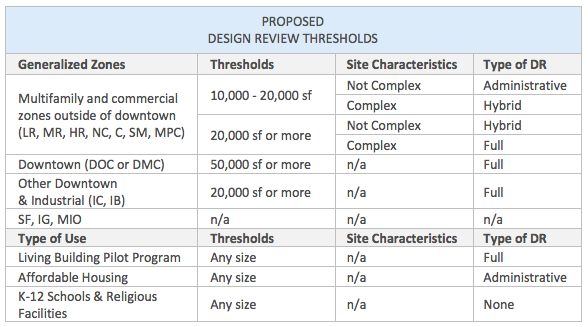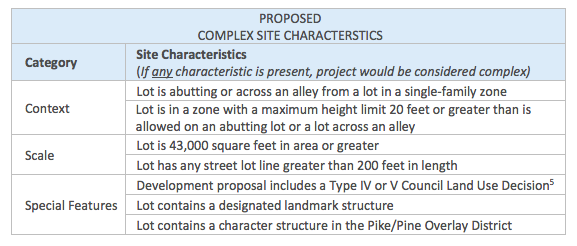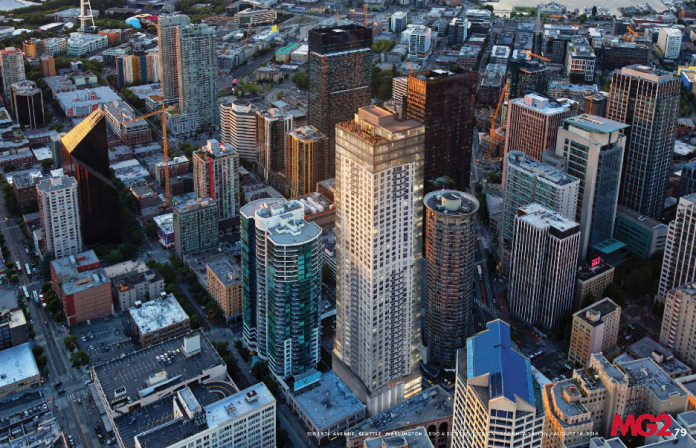Since 1994, Seattle has conducted mandatory design reviews of most large development projects. Design review gives the public (and city planners) a chance to influence decisions that will affect their communities for decades. But this influence comes at a cost. Design review can add months to project timelines; sometimes, the process prevents much-needed housing from getting built at all. And the complex rules for which projects need design review can lead to a niche building boom when a loophole is found–take for example 56-unit microhousing buildings with eight kitchens.
The Seattle Department of Construction and Inspections (SDCI), which administers Seattle’s Design Review Program, thinks that we can do better. In June, SDCI released a proposal to major revamp the Design Review Program for the first time since its creation. On August 1, SDCI presented an updated version of the proposal to the city council.
Much of the proposal remains unchanged from the June draft. It would simplify the rules for which projects must go through design review, and tweak the process to make it faster and more inclusive. The most notable change is to the proposed Hybrid Design Review process, which is being recast as a pilot program. SDCI is also recommending technical changes to the definition of “complex site characteristics”, which influences the level of design review process that a project must go through.
Recap: What’s In The Proposal
SDCI’s proposed changes to the Design Review Program are grouped into three broad pillars.
First, project thresholds would be simplified and adjusted. Thresholds would be based on square footage rather than unit counts. Some smaller projects would be exempted from design review. Conversely, design review would expand to include more institutional uses, and more types of development in industrial areas.
Second, administrative reviews would be expanded. The full design review process requires two phases of review by design review boards; in the administrative process, these reviews are performed by staff instead. The proposal would allow more projects to use the administrative process. It would also create a new “Hybrid Design Review” process, for projects that are large but simple (or that are complex but small), that has one staff review and one board review.
Finally, developers would be required to conduct early community outreach as part of the design review process.
There are also a handful of minor changes, such as adjustments to the membership of design review boards, and limits on the number of review meetings.
Hybrid Design Review: Playing It Safe

The original proposal for Hybrid Design Review had envisioned a two-step process. First, SDCI staff would conduct an Early Design Guidance (EDG) meeting. Later, the local design review board would hold a public meeting, which would make a final recommendation on the project proposal. But, based on comments from both the public and development community, SDCI’s new proposal swaps the order of these two steps. The local design review board would hold a meeting first, while SDCI staff would make the final recommendation.
Even with these changes, the Hybrid Design Review process is an exciting development for those of us who want design review to be faster and more inclusive. It’s encouraging that it survived the first round of public comment.

Size vs. Complexity
To determine which of the three design review processes a project must go through, SDCI is introducing a feature called “complex site characteristics.” Seven different factors can affect whether a project is considered complex, touching on project elements such as site context and scale. More complex projects would require higher levels of public scrutiny, while simpler projects could go through administrative review instead.
In the June proposal, SDCI included an eighth complex site characteristic, which would have considered any site located outside an urban village or urban center. This characteristic was removed from the updated proposal, which will speed up the design review process for small projects outside urban villages and urban centers. On the other hand, the updated proposal reduced the street lot line threshold from 250 feet to 200 feet, which will send more projects through public review.
On the whole, the changes to design review should lead to better outcomes and better community engagement, while also removing roadblocks to development.
Title image features 1903 5th Avenue, courtesy of MG2 Architects.
Doug Trumm is publisher of The Urbanist. An Urbanist writer since 2015, he dreams of pedestrian streets, bus lanes, and a mass-timber building spree to end our housing crisis. He graduated from the Evans School of Public Policy and Governance at the University of Washington in 2019. He lives in Seattle's Fremont neighborhood and loves to explore the city by foot and by bike.


